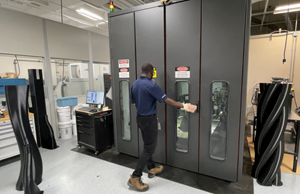
Photo Credit: Getty Images
If you are reading this, there is a very good chance that you are involved in the composites industry somehow. And if you are involved in the composites industry somehow, there is a very good chance that you design or fabricate composite parts and structures and use polymer-based resin systems and fiber-based reinforcements. And if this is the case, then I don’t need to tell you that the supply of many of the resin and fiber materials used by the composites industry have been, over the last few months, in very short supply.
There are multiple reasons for these shortages, and there are multiple material types being affected, but it appears most of the most pain has been felt in the epoxy resin supply chain and the glass fiber supply chain. CW has already reported on the latter in a story you can find on p. 16 of the May 2021 issue, or on the CW website here: “Glass fiber supply chain struggles amid pandemic, economic recovery.” I also discussed the glass fiber supply situation in my March 2021 editorial.
The resin shortage, however, has a different genesis. It was triggered primarily by Winter Storm Uri that afflicted Texas and other southern U.S. states in mid-February 2021. This fast-moving front brought sudden and unusual freezing temperatures as far south as Houston, Texas, which is home to a variety of petroleum-based processing facilities, including oil refineries and polymer manufacturing plants. The cold temperatures disrupted supply of water, natural gas and electricity, thus forcing the facility owners to declare force majeure and shut down.
Hexion (Columbus, Ohio, U.S.), which produces bisphenol-A (BPA, a key ingredient of epoxy) at two facilities in Texas, was forced to cease operations. Similarly, epoxy specialist Olin (Clayton, Miss., U.S.) was forced to shut down all operations at its facilities in Texas, Louisiana, Mississippi and Alabama. These and other shutdowns were consequential not just for the epoxy supply chain, but the vinyl ester supply chain as well, which requires epoxy.
To assess the impact of these widespread shortages, CW, working with Gardner Intelligence (CW and Gardner Intelligence are owned by Gardner Business Media), sent a supply chain survey to the CW audience in early April 2021. We received 144 responses, and from those, learned much about the state of resin and fiber supply. Some highlights:
- When asked which resin systems have been more difficult than usual to acquire in the last three months, 49% of those who responded listed vinyl ester; 49% also listed polyester and 36% listed epoxy.
- When asked which fiber types have been more difficult than usual to acquire in the last three months, 78% of those who responded listed glass fiber; 39% listed carbon fiber.
- The fiber formats in shortest supply, according to respondents, were roving (52%), chopped fiber (43%), woven fabrics (35%) and UD tape (20%).
- The core material in shortest supply was foam (53%).
- The reasons cited for the disruptions was balanced: Shipping delays, not weather-related (56%), high demand (48%), inclement weather (36%). Interestingly, we allowed respondents to list other reasons for disruptions, and “COVID-19” topped that list.
Significantly, we asked how supply chain disruptions have affected the ability to meet customer or contract obligations for delivery of finished parts. Responses here were on a 0-100 sliding scale — the bigger the number the greater the impact. Sixty-two percent of respondents fell in the 51-100 range, which indicates moderate to substantial impact on manufacturing operations.
We also asked respondents to look ahead and estimate when the supply situation would return to normal. The leader here was “unknown,” with 41%, followed by “more than 16 weeks from now,” at 28%. And when asked how concerned respondents were about how the supply disruptions would affect their operations, 55% were either moderately or extremely concerned.
Of course, when supplies tighten, there are options. The vast majority of respondents (65%) said they have communicated the problem to their customers. A large fraction (41%) also sought materials from other suppliers or used an alternative material (38%).
Signals from suppliers and anecdotal feedback we’ve received indicate that this tightening in the supply chain will continue into the summer and possibly the early fall as raw materials and staffing levels return to normal. If you have a story to share about your supply chain challenges, feel free to contact me at jeff@compositesworld.com. And keep an eye on your inbox for this survey — we will send it again soon to find if and how the supply situation is improving.
Related Content
The AAMMC Tech Hub: Ramping U.S. production of large thermoplastic composite aerostructures
CW talks with Syensqo, Spirit AeroSystems and other consortia members about current funding, specification of the next world’s largest press, organizational structure and projects to support U.S. companies in the race to deliver >40,000 sustainable and efficient aircraft over the next 20 years.
Read MoreCo-molding SMC with braided glass fiber demonstrates truck bed potential
Prepreg co-molding compound by IDI Composites International and A&P Technology enables new geometries and levels of strength and resiliency for automotive, mobility.
Read MoreUpdate: THOR project for industrialized, recyclable thermoplastic composite tanks for hydrogen storage
A look into the tape/liner materials, LATW/recycling processes, design software and new equipment toward commercialization of Type 4.5 tanks.
Read MoreEaton developing carbon-reinforced PEKK to replace aluminum in aircraft air ducts
3D printable material will meet ESD, flammability and other requirements to allow for flexible manufacturing of ducts, without tooling needed today.
Read MoreRead Next
Ceramic matrix composites: Faster, cheaper, higher temperature
New players proliferate, increasing CMC materials and manufacturing capacity, novel processes and automation to meet demand for higher part volumes and performance.
Read MoreScaling up, optimizing the flax fiber composite camper
Greenlander’s Sherpa RV cab, which is largely constructed from flax fiber/bio-epoxy sandwich panels, nears commercial production readiness and next-generation scale-up.
Read MoreUltrasonic welding for in-space manufacturing of CFRTP
Agile Ultrasonics and NASA trial robotic-compatible carbon fiber-reinforced thermoplastic ultrasonic welding technology for space structures.
Read More























